St. Nicholas – His Legend and His Role in the Christmas Celebration and Other Popular Customs (By George H. McKnight, 1917) – Chapter 2

CHAPTER II
BIOGRAPHY AND LEGEND
It is quite apparent that the journeys of Santa Claus by night over the housetops, and his various chimney escapades, are beneath the dignity of the reverend Bishop of Myra, formally canonized by the medieval church as St. Nicholas. In appearance, too, Santa Claus is more like an elf, or one of the other beings of Teutonic mythology, than like the Christian bishop whom early artists were fond of representing in full episcopal vestments, with miter, pallium, and pastoral staff. In his manners, too, he is more like a friendly fairy than a patron saint. In reality, as has been seen, in his origin there is more of the pagan than of the Christian. At the same time Christian legend has had its influence. The name Santa Claus is a popular, or juvenile, derivative from St. Nicholas, and the mysterious visit by night which wins for Santa Claus the hearts of children, is closely associated with a famous incident in the life story of the Christian saint.
What then do we know about St. Nicholas? “Of all patron saints,” says Mrs. Jameson, “he is perhaps the most universally popular and interesting. No saint in the calendar has so many churches, chapels, and altars dedicated to him. In England, I suppose, there is hardly a town without one church at least bearing his name.” Both in Eastern Church and Western Church he is the object of extreme veneration, to a degree unequalled in the case of any other saint. It is established that veneration of St. Nicholas goes back to the early centuries in the history of the Christian faith. The Emperor Justinian built a church in his honor at Constantinople about the year 430, and he was titular saint of four churches at Constantinople.
Yet with all this high esteem and veneration through so many centuries, little is known concerning the facts of his life. Historical criticism has demolished much of the story built up around his lovable personality. One by one the cherished tales of his beneficence have been questioned, because lacking the required corroboration of historical evidence. There has even been raised doubt whether he ever existed. In any case certain knowledge is extremely dim. The authorized story of his life set as the lectio or “reading” for the second nocturn of St. Nicholas’ day (Dec. 6th) in the Roman Breviary, makes but a slight narrative. In brief paraphrase it runs as follows:
An only child, in infancy he manifested singular piety. His youth was characterized by deeds of charity, among them one that saved three maidens from a life of shame. In youth, on a sea voyage, he saved the ship in a fearful storm. In youth also he was elected Bishop of Myra, a miraculous sign indicating him to be the divine choice. In later life he succored the oppressed, in particular saving three tribunes unjustly condemned to death. At the Council of Nice he is said to have condemned the Arian heresy, and at his death is said to have received miraculous sign of divine approval. His remains are preserved with the greatest veneration at Bari in Italy.
This sober biography, so lacking in concrete detail, is the life of the beloved saint as sanctioned by the Roman Church of to-day. As already remarked, most even of its meager details have been questioned by higher criticism. In earlier times, however, when the test of reality was not as rigorously applied as is the wont to-day, there flourished a luxuriant growth of stories about St. Nicholas as about other saints, the objects of popular veneration and gratitude.
Much is to be said in favor of the earlier, more imaginative, lives of the saints, legends as they were technically called. It has been remarked, with much truth, that all of us lead double lives, a life of our fancy, in a world of things as they should be, or as we should like them to be, and a life in a world of things as they really are. And this is as it should be. We can lift the level of real existence by thinking of things as we should like them to be. It is well not to walk with one’s eyes always fixed on the ground. The uplift to be derived from the contemplation of things as they should be as distinguished from things as they are, is well exemplified in the case of the legendary stories about St. Nicholas. The fact that these largely imaginative stories existed in the belief of people served to influence human action, leading to imitation which eventually crystallized into some of the noblest of popular customs. In some of the beautiful popular customs connected with the name of St. Nicholas we have the projection into reality of fanciful stories once held worthy of implicit faith.
Much deserves to be said also in favor of the creators of legendary story. One is sometimes disposed to look on such story uncharitably and to regard it as the product of willful intent to deceive. Such is by no means the real explanation of the origin of legendary tales. Such tales are usually the product of intense emotional life, when the imagination becomes heated by prolonged contemplation of any subject. Thus we must explain the revelations to St. Francis and the vivid scenes from the life of Christ attributed to St. Bonaventura. A similar condition serves to explain the popular capacity for belief in tales of the supernatural. We sometimes think of such legendary story as the exclusive product of an earlier, uncritical age. That we are mistaken in this opinion and that the conditions for the production of legendary story continue to exist in our own time, is illustrated in a striking manner by certain highly interesting stories that owe, if not their origin, at least their circulation, to the intensity of feeling aroused by the war in Europe. There has found wide circulation a story concerning certain supernatural occurrences on the battlefield of Mons. “The story goes that at the crisis of the fighting, when the French and English were growing disheartened by their ineffectual efforts to overcome the enemy, certain celestial beings, in the midst of whom was St. George, suddenly appeared between the armies and by their timely aid brought victory to the Allies”. The origin of this story has been clearly explained. Its author, Arthur Machen, in a recent volume, gives a circumstantial account of its creation. It “was conceived and written by me,” he tells us, “in prosaic London, on the last Sunday of August, 1914,” immediately after reading of the retreat from Mons, and this story, for which he chose the title, “The Bowmen,” was published in The Evening News of September 29th the same year. This story then, an admitted fiction, has nevertheless found life in popular belief. It has found not only oral circulation but has been reproduced in print with variants and corroborative testimony. In its circulation it has reached the outermost bounds of the British Empire. How a story which under ordinary conditions would at once be recognized as fiction, now finds ready credence, is revealed in the following extract from a personal letter from far-away Sydney in Cape Breton:
Rev. Mr. —— preached in Falmouth Street Church on Sunday night on the Angels at Mons. I had seen in the papers that the Allies had seen three figures in the sky in the retreat from Mons and that although the Germans pursued them, they never could catch up with them. But I just thought it some Roman Catholic superstition. But Mr. —— thought otherwise. He said reliable people on both sides had undoubtedly seen them, and he thought the age of miracles is not yet past and that if anyone had told him two years ago that he would have been preaching to justify this vision he would have thought him crazy. I really never heard a more wonderful sermon. Rev. Mr. —— has enlisted and goes overseas with the 85th.
The origin of such a miraculous tale and of others of the same kind, such as that of the “Comrade in White,” and the credence given in our own time, by critical, skeptical Protestants, enable one to understand the origin of earlier stories of the supernatural and how in less critical times general credence could be attached to stories to the unsympathetic now often seeming preposterous.
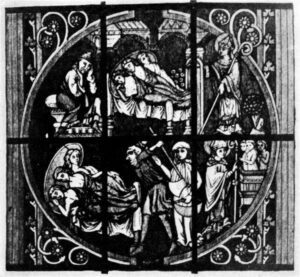
Scenes from the Legend of St. Nicholas in the Stained Glass (thirteenth century) of Bourges Cathedral.
Reproduced from Paul Lacroix, Science and Art of the Middle Ages.
The Church, too, in earlier times was not rigorous in the exclusion of extravagant features in the life history of its heroes. On the contrary it permitted the fancy to play freely about the objects of its veneration, was hospitable to the wonderful, the supernatural, element in story. By various means it aimed to keep ever alive the memory of the saints, not excluding the livelier details contributed by popular tradition. Legendary stories in Latin prose formed a part of the private reading of the clergy in their canonical hours, and in vernacular prose or verse were read before popular congregations in church on the days devoted to the honor of the particular saint. Sometimes they found a place in the story repertory of secular minstrels. Artists other than literary contributed their share toward the perpetuation of the legendary story. The separate scenes in the lives of the popular saints were presented in stained glass windows, particularly in France, in series of pictures on canvas, in wall paintings adorning the chapels devoted to particular saints, especially in Italy, or in sculptured series, in low or in high relief, as architectural ornament or decorating the sides of baptismal fonts as in the case of the St. Nicholas scenes represented in the fonts at Winchester cathedral and elsewhere in England and on the continent.
In even more effective ways the stories were kept alive when the principal scenes were reenacted in dramatic entertainments, by towns or guilds in honor of their particular patron saints, or by schoolboys in honor of their patron Saint Nicholas.
In all these ways the story of St. Nicholas was kept in memory. Of Eastern origin, St. Nicholas became the object of general veneration in the West, especially after the transfer of his remains to Bari in Italy in the year 1087. The especial honor paid to him doubtless finds its explanation in the nature of his life story and the particular needs of earlier times. In the days when the idea that God is love had not become the central feature of Christianity, when God was regarded rather as a judge, just but therefore severe, suffering humanity felt the need of a more approachable divine personality. This place of intermediary between man and divine justice was taken in part by Our Lady, the Divine Mother, and almost countless are the Miracles de Notre Dame, the tales of aid afforded by her to human beings in distress. A similar part was played to some extent by each of the popular saints, but above all by St. Nicholas, who was the principal agent in many stories of this kind.
It is my purpose, then, to take up in detail the story of St. Nicholas as found in these earlier records, which reflect so well the devotion felt for the most thoroughly human of all the saints. Though many elements pass the bounds of modern credulity, they serve to express the loving reverence felt for the saint who, second only to Our Lady herself, was looked to as the beneficent source of aid in times of human distress, and at the same time serve to explain some of the most interesting of popular customs.






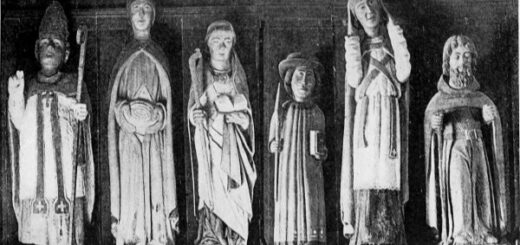




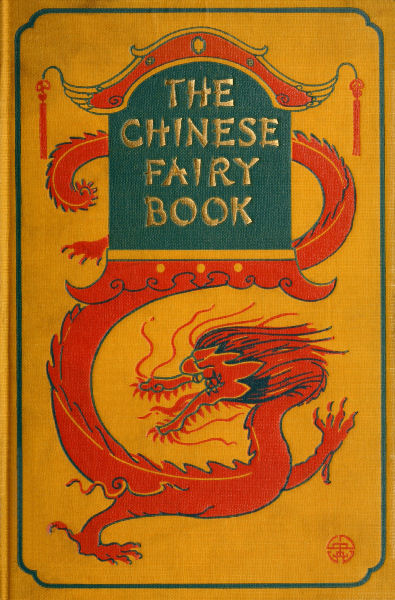



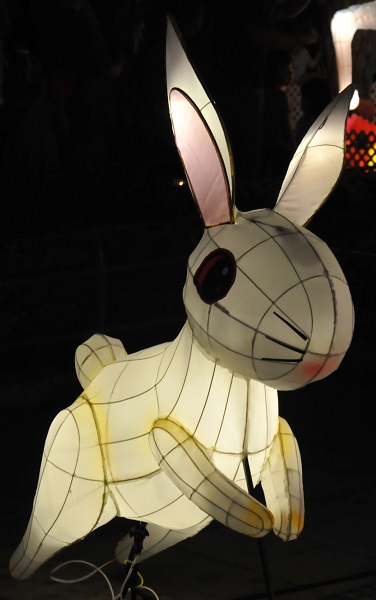



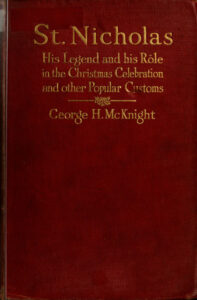
1 Response
[…] St. Nicholas – Chapter 2 […]